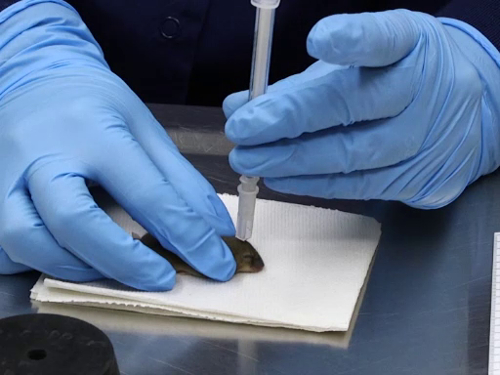화합물 투여 III
Overview
출처: 케이 스튜어트, RVT, RLATG, CMAR; 발레리 A. 슈뢰더, RVT, RLATG. 노틀담 대학교, IN
실험실 마우스와 쥐에서 화합물 관리를 위한 많은 일반적으로 사용 되는 경로. 그러나, 특정 프로토콜 은 상인, 비강 내 및 두개 내 주사를 포함하여 덜 일반적으로 사용되는 경로의 사용을 요구할 수 있습니다. 이러한 절차를 성공적으로 수행하기 위해서는 전문 교육이 필수적입니다. 이러한 경로에 대한 정당성은 기관 동물 관리 및 사용 위원회 (IACUC) 승인을 얻기 위해 제공 될 수있다.
Procedure
1. 인트레이더말 관리
- 대부분의 상인 주사는 수성 기반 화합물. 주사 부위에서 조직 괴사를 피하기 위해 중성 pH를 갖기 위해 생리적으로 완충되어야 한다.
- 바늘 크기 범위는 25-30 게이지이며 가능한 가장 작습니다.
- 주사 부위당 투여량 범위는 50-100 μL입니다. 과도한 부피를 주입하면 주사 부위에 괴사또는 압력으로 인해 화합물이 누출될 수 있다.
- 빈상인 공간에 바늘을 정확하게 배치하려면 쥐와 쥐를 마취할 필요가 있습니다. 흡입 마취는 급속한 유도 및 회복을 허용합니다; 그러나, 주 사용 마취는 지역의 준비를 위한 충분한 시간을 제공하고 주입을 능력을 발휘하는 장점이 있습니다. 1
- 탈필 크림을 사용하거나 부위를 면도하여 주사 부위에서 머리카락을 제거하십시오.
- 잔류 제분 크림이나 헤어 이물질을 철저히 제거하십시오.
- 요오드 용액, 클로르헤시딘 용액 또는 알코올과 같은 국소 살균제를
Application and Summary
동물로 화합물의 관리 동물의 웰빙과 실험 데이터 및 과학적 가치의 결과 모두에 중요 한 영향을 미칠 수 있습니다. 적절한 전달 방법은 실험의 성공에 필수적입니다. 연구의 과학적 목표, 물질의 pH, 필요한 투여량, 물질의 점도, 동물의 웰빙 등 최상의 경로를 결정하는 데 많은 요소를 고려해야 합니다. 기술 전문 지식은 또한 모든 주입 방법에 대한 요구 사항입니다.
References
- Turner, P.V., Pekow, C., Vasbinder, M. A., and Brabb, T. 2011. Administration of substances to laboratory animals: equipment and considerations, vehicle selection, and solution preparation. JAALAS. 50: 614-627.
- Dhuria, S.V., Hanson, L.R., and Frey II, W.H. 2010. Intranasal delivery to the central nervous system: mechanisms and experimental considerations. Journal of Pharmaceutical Sciences. 99: 1654-1673.
- Stevens, J., Suidgeest, E, Van der Graaf, P.H., Danhof, M., and De Lange, E.C. 2008. Development and evaluation of a new, minimal-stress animal model for intranasal administration in freely moving rats. Poster presentation at American Association of Pharmaceutical Scientists Annual Meeting, Atlanta, Georgia.
- Morton, D.A., Jennings, M., Buckwell, A., Ewbank, R., Godfrey, C., Holgate, B., Inglis, I., James, R., Page, C., Sharman, I., Verschoyle, R., Westall, L., and Wilson, A.B. 2001. Refining procedures for the administration of substances Report of the BVAAWF/FRAME/RSPCA/UFAW Joint Working Group on Refinement. Members of the Joint Working Group on Refinement. Laboratory Animals. 35: 1-41.
Tags
건너뛰기...
이 컬렉션의 비디오:

Now Playing
화합물 투여 III
Lab Animal Research
31.4K Views

설치류 취급 및 통제 기술
Lab Animal Research
174.4K Views

실험실 기본 관리
Lab Animal Research
28.0K Views

사육 및 이유의 기초
Lab Animal Research
35.7K Views

설치류 식별 I
Lab Animal Research
54.7K Views

설치류 식별 II
Lab Animal Research
25.6K Views

화합물 투여 I
Lab Animal Research
100.5K Views

화합물 투여 II
Lab Animal Research
34.9K Views

화합물 투여 IV
Lab Animal Research
51.6K Views

혈액 채취 I
Lab Animal Research
171.5K Views

혈액 채취 II
Lab Animal Research
73.2K Views

마취 유도 및 유지
Lab Animal Research
50.4K Views

설치류 수술에 대한 고려 사항
Lab Animal Research
22.5K Views

진단 부검 및 조직 수확
Lab Animal Research
58.0K Views

멸균 조직 수확
Lab Animal Research
34.8K Views
Copyright © 2025 MyJoVE Corporation. 판권 소유



